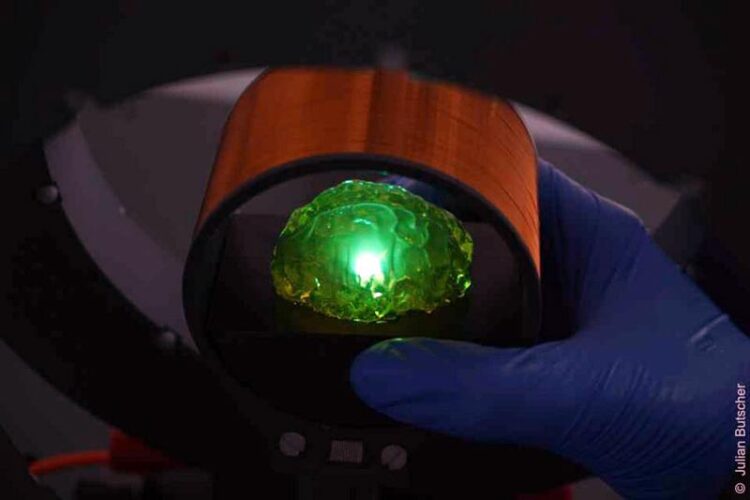Tiny wireless light bulbs for biomedical applications

Wirelessly powered light bulb illuminating a transparent brain phantom
Credit: Julian Butscher
A research team from the University of St Andrews and the University of Cologne has developed a new wireless light source that might one day make it possible to ‘illuminate’ the human body from the inside. Such light sources could enable novel, minimally invasive means to treat and better understand diseases that today require the implantation of bulky devices. The study was published under the title ‘Wireless Magnetoelectrically Powered Organic Light-Emitting Diodes’ in Science Advances.
The new approach presented by the scientists from Germany and Scotland is based on the integration of organic light-emitting diodes (OLEDs) on ‘acoustic antennas’. Acoustic antennas are currently being explored for various applications such as the detection of low magnetic fields. As a major advantage over electric antennas, acoustic antennas can be designed to be much smaller. OLEDs are commonly found in modern smartphones and high-end televisions and consist of thin layers of organic materials that can be applied to almost any surface. In their work, the researchers exploit this property to deposit OLEDs directly onto the acoustic antenna, thus merging the unique properties of both platforms into a single extremely compact device. In this way, the acoustic antennas serve as substrate and power source for the custom-developed OLED. They convert energy from a magnetic field into a mechanical oscillation and subsequently into an electric current by means of an effect known as the composite magnetoelectric effect.
The new devices operate at sub-megahertz frequencies, a frequency range used for example for submarine communication, as electromagnetic fields at this frequency are only weakly absorbed by water. However, unlike in submarines, the intended application in biomedicine requires a small device in order to avoid a negative impact on the tissue.
In recent years, optical stimulation techniques have emerged as a promising alternative to electrical stimulation because they can be more cell selective and even enable the stimulation of individual cells. Such techniques have already shown promising results in early clinical trials, for instance, to treat an otherwise untreatable eye disease.
“Our novel wireless light source combines minimal device size, low operation frequency and optical stimulation,” said Humboldt Professor Dr Malte Gather, head of the Humboldt Centre for Nano- and Biophotonics at the Department of Chemistry of the University of Cologne’s Faculty of Mathematics and Natural Sciences. “Many emerging applications require multiple sites to be stimulated independently, which is why modern brain stimulators often incorporate a large number of electrodes. In the case of our wireless light sources, the devices can be independently controlled and operated without the need of additional and potentially bulky electronics.”
This is possible because the operation frequencies of different acoustic antennas can be tuned to different values. In the future, this could allow for the individual control of multiple stimulators in different parts of the body, for example to treat tremor in the late stages of Parkinson’s disease. As a next step, the researchers aim to further reduce the size of their wireless OLEDs and to test their technology in an animal model.
Journal: Science Advances
DOI: 10.1126/sciadv.adm7613
Method of Research: Experimental study
Subject of Research: Not applicable
Article Title: Wireless magnetoelectrically powered organic light-emitting diodes
Article Publication Date: 6-Mar-2024
Media Contact
All latest news from the category: Medical Engineering
The development of medical equipment, products and technical procedures is characterized by high research and development costs in a variety of fields related to the study of human medicine.
innovations-report provides informative and stimulating reports and articles on topics ranging from imaging processes, cell and tissue techniques, optical techniques, implants, orthopedic aids, clinical and medical office equipment, dialysis systems and x-ray/radiation monitoring devices to endoscopy, ultrasound, surgical techniques, and dental materials.
Newest articles

Innovative 3D printed scaffolds offer new hope for bone healing
Researchers at the Institute for Bioengineering of Catalonia have developed novel 3D printed PLA-CaP scaffolds that promote blood vessel formation, ensuring better healing and regeneration of bone tissue. Bone is…

The surprising role of gut infection in Alzheimer’s disease
ASU- and Banner Alzheimer’s Institute-led study implicates link between a common virus and the disease, which travels from the gut to the brain and may be a target for antiviral…

Molecular gardening: New enzymes discovered for protein modification pruning
How deubiquitinases USP53 and USP54 cleave long polyubiquitin chains and how the former is linked to liver disease in children. Deubiquitinases (DUBs) are enzymes used by cells to trim protein…



